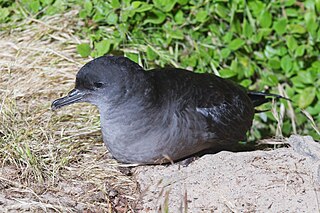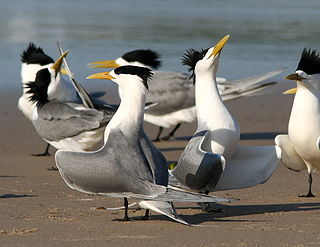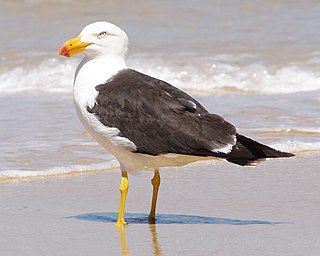The Oyster Rocks are a close pair of small granite islands, with a combined area of about 6 ha, in south-eastern Australia. They are part of Tasmania’s Tin Kettle Island Group, lying in eastern Bass Strait between Flinders and Cape Barren Islands in the Furneaux Group. They are a conservation area. The islands are part of the Franklin Sound Islands Important Bird Area, identified as such by BirdLife International because it holds over 1% of the world populations of six bird species.

The Needle Rocks, also known as the Needles, are a group of five main rock islets located close to the south-western coast of Tasmania, Australia. With a combined area of approximately 10.5 hectares (0.041 sq mi), the islets are part of the Maatsuyker Islands Group, and comprise part of the Southwest National Park and the Tasmanian Wilderness World Heritage Site.

Steep Island, also known as Steep Head, is a 21.6 ha island in Bass Strait in south-eastern Australia. It is part of Tasmania’s Hunter Island Group and lies between north-west Tasmania and King Island. It was once used for grazing sheep but title has been transferred to the Tasmanian Aboriginal community; with an estimated 250,000 shearwater burrows present, it is principally used for muttonbirding.

Bird Island is an island game reserve, with an area of 43.92 ha, in Bass Strait, south-eastern Australia. It is part of Tasmania’s Hunter Island Group which lies between north-west Tasmania and King Island. It is home to about 5,000 pairs of short-tailed shearwaters, the young of which are harvested annually, and about 3,000 pairs of little penguins.

Stack Island is an island game reserve, with an area of 23.7 ha and a high point 54 m above sea-level, in Bass Strait, south-eastern Australia. It is part of Tasmania’s Hunter Island Group which lies between north-west Tasmania and King Island.
Dugay Islet is a small island with an area of 0.44 ha in Bass Strait, north-western Tasmania.
Edwards Islet is a small island with an area of 0.58 ha in Bass Strait, south-eastern Australia. It is part of Tasmania’s Hunter Island Group which lies between north-west Tasmania and King Island.

Penguin Islet is a small island nature reserve with an area of 3.46 ha in Bass Strait, south-eastern Australia. It is part of Tasmania’s Hunter Island Group which lies between north-west Tasmania and King Island. It is notable as the only pelican colony in western Bass Strait.
Bears Island is a small island with an area of 0.34 ha, lying off the north-west tip of Three Hummock Island in Bass Strait, south-eastern Australia. It is part of Tasmania’s Hunter Island Group which lies between north-west Tasmania and King Island.

Black Pyramid Rock is an island nature reserve, with an area of 40 ha, in Bass Strait, south-eastern Australia. It is part of Tasmania’s Hunter Island Group which lies between north-west Tasmania and King Island. It is part of the Albatross Island and Black Pyramid Rock Important Bird Area. It is notable for its Australasian gannet colony which, at over 12,000 pairs, is the largest in Tasmania and supports about 20% of the world population of the species.
South Black Rock is a small island with an area of <1 ha, in Bass Strait, south-eastern Australia. It is part of Tasmania’s Hunter Island Group which lies between north-west Tasmania and King Island.

Trefoil Island , officially known as titima / Trefoil Island, is an island with an area of 115.79 ha, in south-eastern Australia. It is part of Tasmania’s Trefoil Island Group, lying close to Cape Grim, Tasmania's most north-westerly point, in Bass Strait. It is owned by the Trefoil Island Aboriginal Cooperative and is home to an estimated 1.5 million breeding pairs of short-tailed shearwaters, which are subject to annual muttonbirding activities. Approval is required to visit.

Little Trefoil Island is a small island with an area of 0.64 ha, in south-eastern Australia. It is part of Tasmania’s Trefoil Island Group, lying close to Cape Grim, Tasmania's most north-westerly point, in Bass Strait.

The Harbour Islets are a group of two adjacent small rocky islands, joined at low tide, part of Tasmania’s Trefoil Island Group, lying close to Cape Grim, Tasmania's most north-westerly point, in Bass Strait, with a combined area of 3.13 ha, in south-eastern Australia.

The Murkay Islets are a group of several small rocky islands, some of which are joined at low tide, with a combined area of about 0.5 ha, part of Tasmania’s Trefoil Island Group, lying close to Cape Grim, Tasmania's most north-westerly point, in Bass Strait.
The Shell Islets are a group of a small islands in south-eastern Australia with two subsidiary islets, surrounded by extensive sand and mudflats at low tide, with a combined high tide area of 0.082 ha. They are part of Tasmania’s Trefoil Island Group, lying close to Cape Grim, Tasmania's most north-westerly point, in Bass Strait.
South West Petrel Island is an island game reserve with an area of 4 ha, part of the Petrel Island Group, lying in Bass Strait close to Walker and Robbins Islands in north-west Tasmania, Australia.
Big Stony Petrel Island is an island game reserve with an area of 7.2 ha, in south-eastern Australia. It is part of the Petrel Island Group, lying in Bass Strait close to Walker and Robbins Islands in north-west Tasmania.
Half Tide Rock is a small rocky island with an area of 0.13 ha, in south-eastern Australia. It is part of the Petrel Island Group, lying in Bass Strait close to Walker and Robbins Islands in north-west Tasmania.

Wright Rock is a small, steep-sided granite island, with an area of 9.36 ha, in south-eastern Australia. It is part of Tasmania’s Bass Pyramid Group, lying in northern Bass Strait between Flinders Island and the Kent Group. It has been a nature reserve since 5 April 1978.









